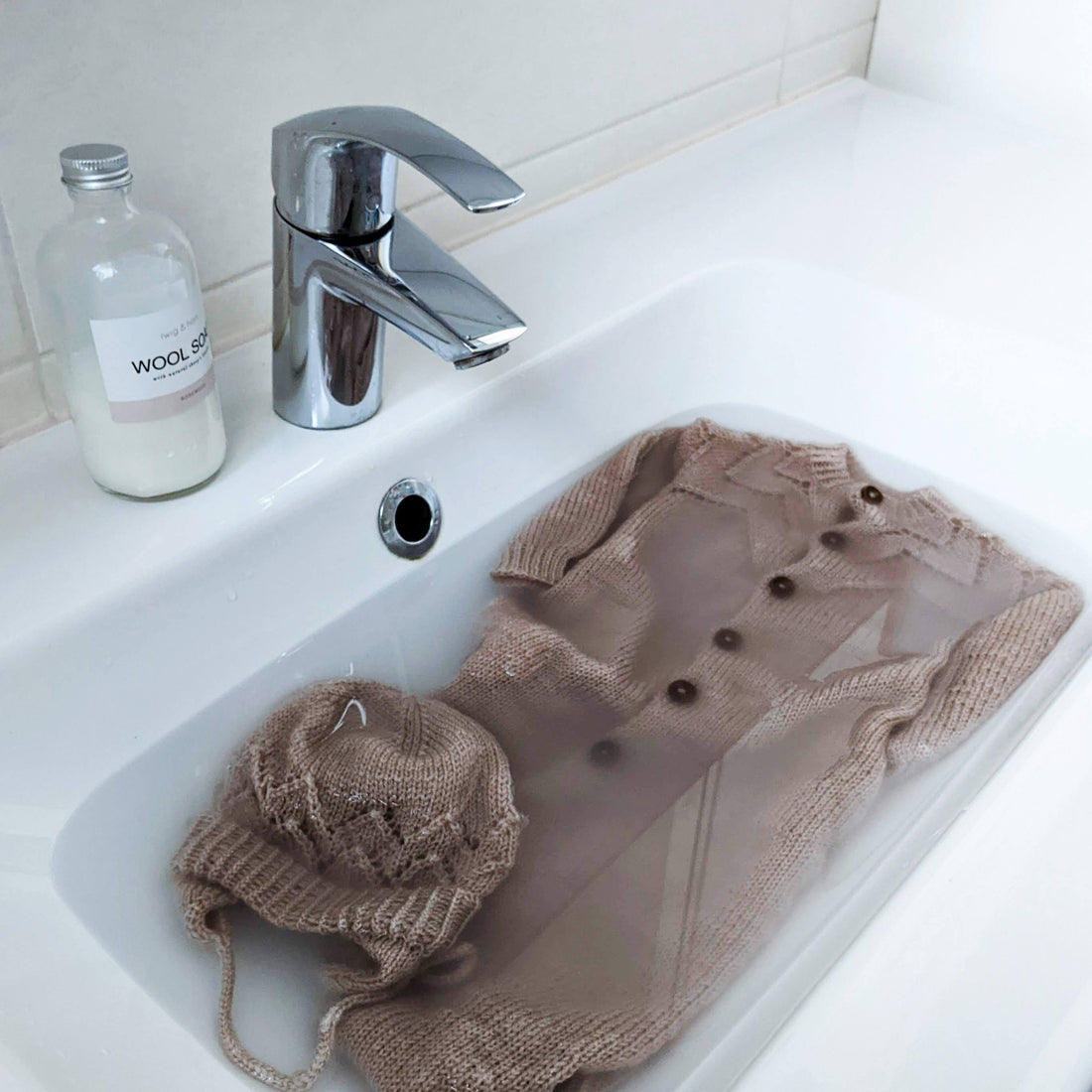Finally finished! The jacket is knitted, the last threads are sewn up, the buttons are fastened - and now put it on straight away? Or would you rather wash it again?
In all of our instructions, we recommend washing a freshly knitted piece before it is used or given away. However, many are unaware of why we do this. This step is often left out for fear that the piece could stretch out, felt or look "used" from the wash. Here we explain why we always wash each piece before use and what you have to consider.

Why should you wash a finished piece of knitting?
There are many reasons here. Wool goes through many hands before it is knitted. When stored in stores and at home, it collects dust and dirt and is often touched, felt and put back. Sweat and fat from your hands (we don't even want to talk about biscuit crumbs or coffee splashes...) come with knitting. Dyed yarns often contain excess dye as well, which is rinsed out in the first wash - I'm always fascinated by how the water looks after the wash! That alone would be a reason for me to wash the piece, but it goes even further:
A quick rinse with water relaxes the fibers (that's why washing knitwear is often referred to as a "relaxation bath") and makes the stitch structure much more even. Some yarns even thrive in water.

The before and after difference is particularly noticeable with hole patterns, which only really open up when they are washed, and with elements such as button plackets, flounces or the decreases in hats: what was previously irregular and wrinkled can be smoothed out and given shape by careful washing be placed.

For me, a piece of knitwear is never finished until it has been washed - only then has it reached its final shape. A proper wash doesn't make it look used or old, just gives it the finishing touch. Sooner or later, every piece of clothing has to be washed anyway - then I prefer to do the first wash myself instead of giving the piece away unwashed, so that the recipient doesn't wonder later why their jacket looks completely different after a wash than before.

How do you wash knitwear properly?
There is no one-size-fits-all answer to washing properly - each yarn composition has its own requirements. That's why you should first look at the care instructions on the banderole and, if in doubt, strictly follow them.
However, there are some basic rules: the more natural the fiber is, the more sensitive it is to the wash. This applies in particular to silk, cashmere, mohair or alpaca, but also to merino yarns that are not superwash treated. According to the banderole, these yarns only have to be washed by hand - but a good wool program in the washing machine is usually also possible. Below we explain what needs to be considered.
Superwash-treated wool (many merino yarns and blends with acrylic), on the other hand, should rather be washed directly in the machine and can also withstand a normal washing program - just pay attention to the recommended temperature on the sleeve and only gently spin the pieces.
hand wash
We simply wash most of the smaller items (baby and children's sweaters, hats, gloves, etc.) in the sink. This is how it works:

1st step: The knitted piece is finished - all threads are sewn up, all buttons are fastened.

Step 2 : First fill the sink with cold to lukewarm water and add some wool soap if necessary (if you don't have any, a dash of mild shampoo will do). Only put the knitted piece in the water when the sink is full - some fine yarns are sensitive to temperature fluctuations. Then leave the piece in the water for a few minutes. Squeeze it out gently every now and then to get it really wet.

Step 3: Carefully take the piece out of the water. Warning: the larger the piece, the greater the risk that it will warp here! So don't just pull a sweater out of the water by one sleeve, but hold it as compactly as possible in your hand. Gently squeeze out excess water, but don't wring the piece, this can also warp it.
Then lay it out on a dry towel and roll it up tightly so that the towel absorbs a lot of moisture.

Step 4: Unroll the piece again. Now lay it very carefully on a second dry towel. Pay attention to the details here: Lay it flat, pull the button placket and the cuffs into shape, smooth the hat and the ear bands and so on - this is where the piece gets its final shape, small blemishes can now be touched up. Then let the piece dry flat - never hang it on a hanger or over the heater, as this can warp it or get visible creases. Do not let light-colored pieces dry in direct sunlight, white wool can yellow in sunlight.

Complete!
Wash wool in the washing machine
Basically, we wash every yarn in the washing machine, even delicate yarns like silk or mohair. We have tested our machines and trust the wool programs. There are a few important points: Pay attention to the water temperature. We wash wool in cold water or at a maximum of 20°C - delicate yarns can felt at higher temperatures. We use special wool detergent, as normal washing powder could damage the fibers - if in doubt, liquid detergent is better than washing powder. Never use fabric softener!
Make sure to spin the knitted pieces only a little. Especially large, heavy pullovers wear out quickly, which is why we spin at a maximum of 400 revolutions per minute. If you put the piece in a laundry net beforehand, you can also spin it more vigorously, but we advise against this, especially for pieces with mohair, as they can felt faster in the net.
With these tips, washing in the washing machine should work - but if in doubt, always test your machine with an old or small piece before you wash your brand new sweaters in it!
Once you have removed the piece from the machine (carefully so that nothing becomes distorted!), let it dry lying on a towel, carefully shaped like you would after a hand wash.
Can wool go in the dryer?
The short answer is "not really" - it can felt, shrink or pill quickly. Some yarns hold up better in the tumble dryer than others (and some are explicitly labeled as "suitable for tumble drying", e.g. Merino 100%, Merino Tweed or Merino Sport by Katia), but in general we would avoid it.
However, if an item, even made of delicate wool, is too stretched out in the wash, the dryer can help - put the damp item in the dryer with a towel and let it run on a low temperature. Check again and again so that the piece does not shrink too much until it is hopefully the right size again. However, this does not work with every yarn and does not make the piece more beautiful - so this should rather be the last resort before you throw away the piece, and only at your own risk :)

